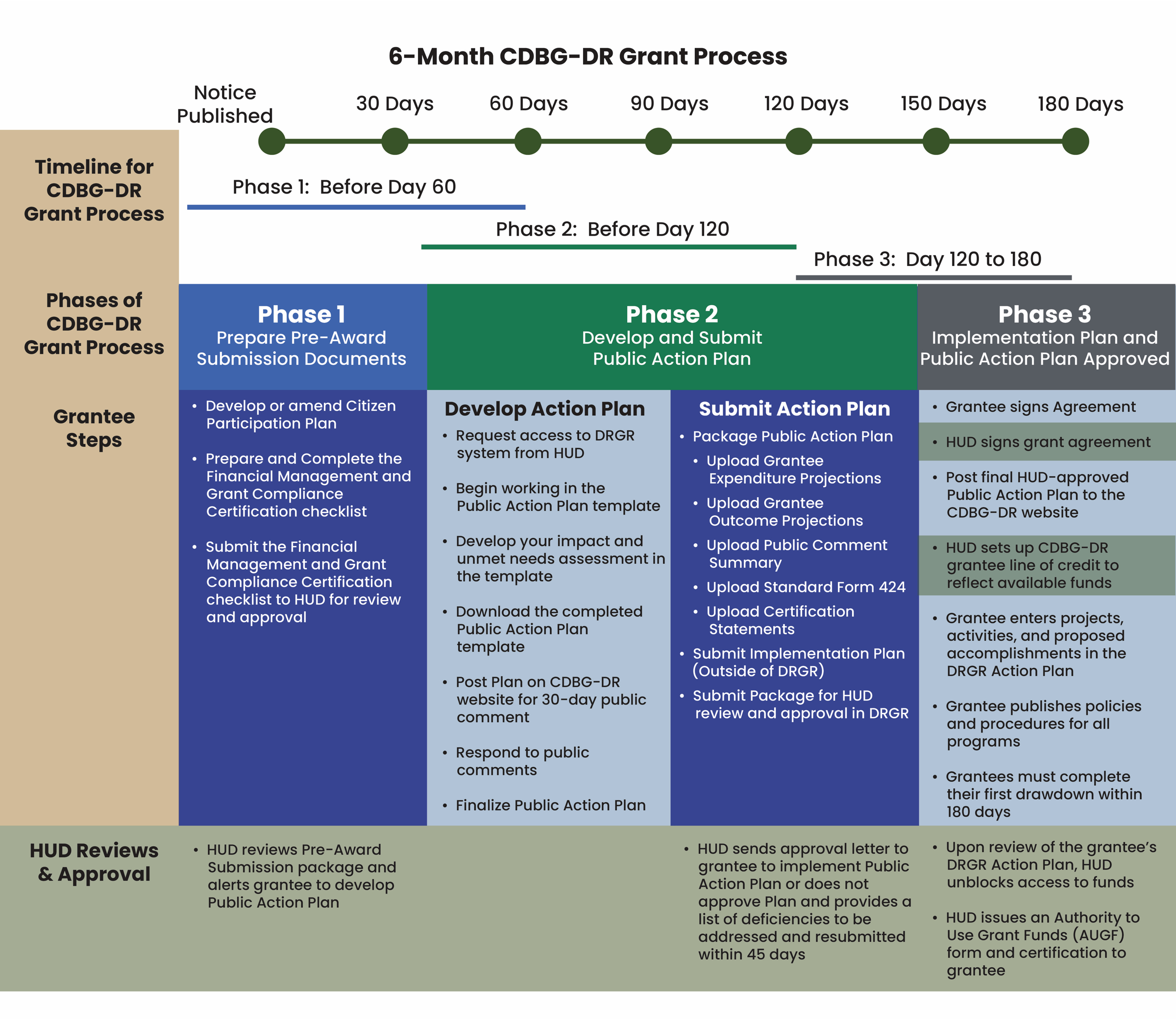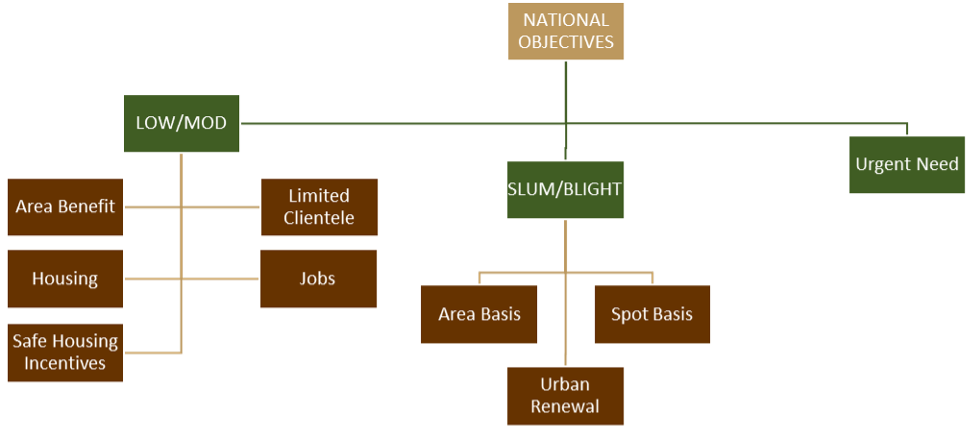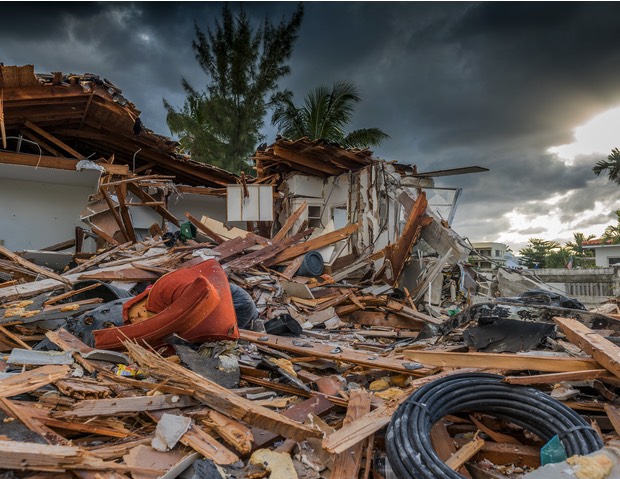SECTION 1: General Overview
This guidance is designed for recipients of Community Development Block Grant Disaster Recovery (CDBG-DR) funds. Learn more about the requirements in the CDBG-DR Consolidated Notice and how to meet the requirements throughout each phase of the grant process—pre-award grantee submissions; grantee steps and timelines; and action plan development, submittal, and implementation.
CDBG-DR Grant Process
When you click on the image, it will open a new window displaying accessibility text details.

HUD and the grantee must complete the following steps before a grantee can begin expending CDBG-DR funds.
-
The grantee must develop or amend its citizen participation plan to incorporate disaster recovery efforts.
-
Within 60 days of the applicability date of the Allocation Announcement Notice (or when the grantee submits its action plan, whichever is earlier), the grantee must submit documentation for the Financial Management and Grant Compliance Certification Requirements as described in the Consolidated Notice and should coordinate with their grant mangers when submitting.
-
The grantee must request and receive Disaster Recovery Grant Reporting (DRGR) system access (if the grantee does not already have DRGR access) so the approved grantee staff can enter the Public Action Plan into the DRGR system.
-
The grantee must download its draft Public Action Plan from the DRGR system and publish it for public comment on the grantee’s disaster recovery website for no less than 30 calendar days. The grantee must consider all comments that are received orally or in writing. Additionally, the grantee must respond to public comments and provide a summary of the comments to HUD with the Public Action Plan in DRGR.
-
The grantee must submit its Implementation Plan, Public Action Plan (which includes Standard Form 424 (“SF-424”), and projection of expenditures and outcomes to HUD not later than 120 days from the applicability date of the Allocation Announcement Notice. NOTE: The Public Action Plan and projection of expenditures and outcomes will be submitted through DRGR, and grantees should coordinate with their grant mangers when submitting the Implementation Plan.
-
HUD reviews (allotted 60 days from date of receipt) and approves the Public Action Plan in DRGR according to criteria identified in the Consolidated Notice.
-
HUD sends a Public Action Plan approval letter to the grantee. If the Public Action Plan is not approved, HUD will notify the grantee of the deficiencies, the grantee must then resubmit the Public Action Plan via DRGR within 45 days of the notification.
-
HUD sends a grant agreement to the grantee.
-
The grantee must sign and return the grant agreement to HUD.
-
HUD signs the grant agreement and establishes the grantee’s CDBG-DR line of credit amount to reflect the total amount of available funds.
-
The grantee must publish the final HUD-approved Public Action Plan on its official website.
-
The grantee must enter projects, activities, and proposed accomplishments into the DRGR Action Plan (Projects and Activities) and submit the DRGR Action Plan to HUD. NOTE: Only funds budgeted for activities established in the DRGR system can be drawn from the grantee’s line of credit.
-
HUD reviews and approves the grantee’s DRGR Action Plan to unblock access to funds.
-
The grantee must complete its first drawdown within 180 days. Grantees can drawdown funds after the Responsible Entity completes the applicable environmental review(s) pursuant to 24 CFR part 58 or as authorized by the Appropriations Act and, as applicable, and receives from HUD an approved Authority to Use Grant Funds (AUGF) form and certification.
-
The grantees must publish (on their website) policies and procedures for all programs and key recovery operations implemented by the grantee with CDBG-DR funds.
National Objectives
To meet a CDBG-DR national objective, all activities must:
-
Benefit LMI persons;
-
Aid in the prevention or elimination of slums or blight; or
-
Meet other community development needs having an urgency because existing conditions pose a serious and immediate threat to the health or welfare of the community where other financial resources are not available to meet such needs (known as “Urgent Need”).

Some activities are presumed to meet a national objective (e.g., general/non-project specific planning for local governments; program administrative costs). In most cases, however, CDBG-DR grantees must demonstrate that CDBG-DR assisted activities comply with regulatory criteria to demonstrate that they meet a national objective. The timing of documenting that an activity will meet a national objective is an important consideration. Compliance with national objectives are encouraged to be documented upfront, when possible. However, some national objectives can be documented over time. For example, it is likely that the future occupants of a rental rehabilitation activity cannot be identified up-front. Compliance with the LMI housing national objective requires that 51 percent of the occupants be LMI households, will require documentation demonstrating compliance during the leasing period until the national objective is met.
When using the Urgent Need national objective for CDBG-DR activities, the requirements can be different from the regulatory criteria in CDBG depending on when the activity is included in the grantee’s Action Plan. The Consolidated Notice describes a waiver and alternative requirement for the use of the urgent need national objective during a 36-month period after the applicability date of the applicable Allocation Announcement Notice. This waiver and alternative requirement recognize how a CDBG-DR grantee is limited to spending funds for the benefit of areas that have received a presidential disaster declaration and the need to expedite the grantee’s recovery. When a grantee describes the urgency of the situation in its unmet needs assessment; identifies the program and activity to use urgent need; and documents how the activity responds to the urgency, type, scale, and location of the disaster-related impact within the allotted period, the grantee will not need to submit the documentation required under section 104(b)(3) of the HCDA.

Unmet recovery needs change over time as resources from different sources have been expended. After 36 months, when the waiver and alternative requirement has expired, the CDBG-DR grantees should follow the criteria identified in section 104(b)(3) of the HCDA for any new activities added to the action plan without impeding the recovery. Grantees may request an extension for the established waiver and alternative requirement if the grantee’s request is accompanied by data and can demonstrate that following the criteria identified in section 104(b)(3) of the HCDA would impede recovery.
Please note, the Consolidated Notice waives section 104(b)(3) of the HCDA in its entirety, where previous waivers for CDBG-DR grantees may have only temporarily waived the documentation requirements.
Most Impacted and Distressed Areas
CDBG-DR appropriation acts typically require that all funds benefit the most impacted and distressed (MID) areas resulting from a major disaster. MID areas can be designated by both HUD and the CDBG-DR grantee. The eligible disasters and any geographic restrictions are identified in the Allocation Announcement Notice. A geographic community may include counties, cities, towns, neighborhoods, schools, or other government districts, or a collection of ZIP codes. Typically, 80 percent of the CDBG-DR grant must address unmet disaster needs within the HUD-identified MIDs, which can be found in the Allocation Table in the applicable Allocation Announcement notice. The CDBG-DR grantee may determine where to use the remaining 20 percent of the allocation, but that portion of the allocation may only be used to address unmet disaster needs in areas that the CDBG-DR grantee determines are MIDs (the “Grantee-identified MIDs”) resulting from the same major disaster that led to the HUD-designated MID areas.
Grantees are encouraged to share their methodology for selecting the Grantee-identified MIDs with the public.
For example, a grantee may select a county or ZIP code that received both FEMA Individual Assistance (IA) and Public Assistance (PA) and was not included as a HUD-identified MID area. Most areas that receive both FEMA IA and PA suffered extensive damage from the qualifying disaster.
Additionally, grantees have discretion when distributing funds within the MID areas. For increased transparency, grantees are encouraged to describe its methodology for identifying Grantee-identified MIDs, and any MID prioritizations (if applicable) in the action plan. Priorities for MID areas may differ from the criteria used by a grantee when competitively selecting recipients or disbursing funds through a method of distribution. Describing the methodology for identifying or prioritizing MIDs in the action plan is important for increasing awareness and understanding for eligible beneficiaries.

A Guide on How CDBG-DR Grantees Can Meet the Requirements of the Consolidated Notice